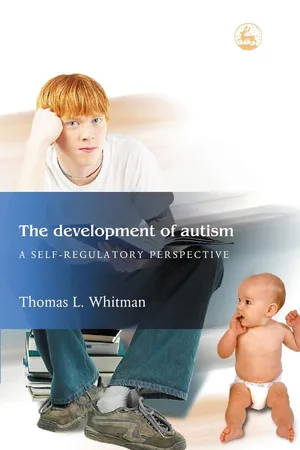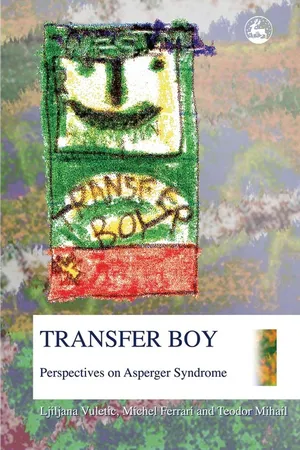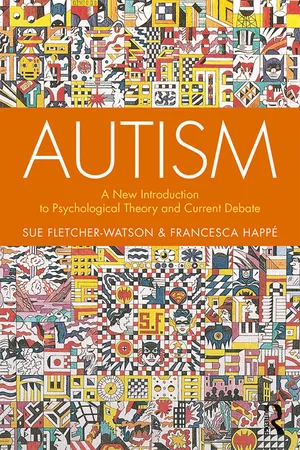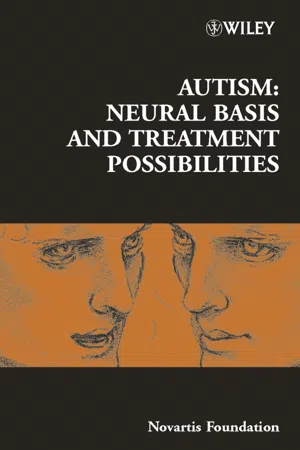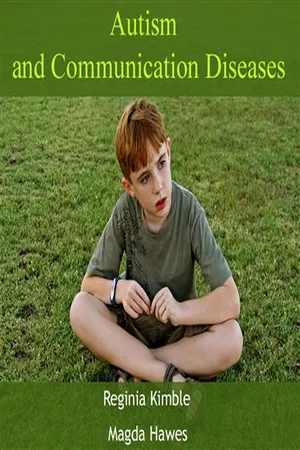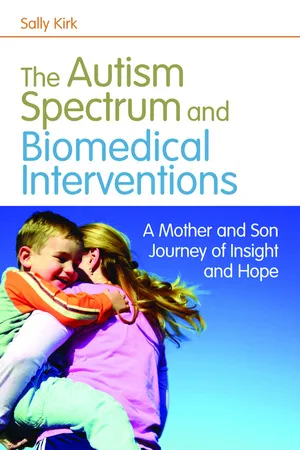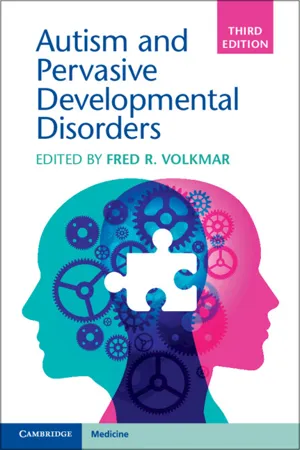Psychology
Biological Explanations for Autism
Biological explanations for autism suggest that genetic and neurological factors play a significant role in the development of the condition. Research has identified specific genes and brain abnormalities associated with autism spectrum disorder (ASD). These biological factors are believed to contribute to the atypical social, communication, and behavioral patterns observed in individuals with autism.
Written by Perlego with AI-assistance
Related key terms
1 of 5
11 Key excerpts on "Biological Explanations for Autism"
- eBook - ePub
The Development of Autism
A Self-Regulatory Perspective
- Thomas L. Whitman(Author)
- 2004(Publication Date)
- Jessica Kingsley Publishers(Publisher)
Theories of autism can be typically subdivided into those that are psychological or biological. Psychological theories specify the role that different processes, such as those involving the attention or the sensory system, play in symptom development. In contrast, biological theories emphasize how various factors such as genes, neurochemical processes, neurological structures, and environmental toxins influence symptom formation. Ideally, psychological theories should be consistent with what is known biologically about autism. Conversely, biological theories should be consistent with what is known psychologically.A variety of theories of autism have been proposed. Many of these theories are quite descriptive and not very formalized in their presentation. Most theories of autism are quite speculative and in need of empirical verification. Moreover, most theories are narrow in scope, focusing on only a few of the symptoms associated with autism. Theory formulation in the area of autism is particularly difficult because of the number and heterogeneous nature of the symptoms. At present, it is not clear which symptoms of autism are primary, that is, are a critical part of an early process leading to other symptoms. Ideally a comprehensive theory of autism should emphasize how biological, psychological, and environmental factors can work in conjunction to explain the development of autism. Moreover, to be really useful, a theory of autism should specify how biological and/or psychobehavioral interventions can be structured to address the underlying causes of autism so as to prevent or ameliorate the symptoms associated with this disorder. Although there is empirical support for some theories of autism, no one theory has emerged that has gained broad acceptance. Because of the rapidly increasing scientific interest in autism, it is likely that the theoretical landscape will change dramatically in the next decade.In this chapter current theories of autism are briefly reviewed. Special attention is given to social–environmental, psychological, and biological theories. The social–environmental theories focus on how the family and other social factors influence the development of autism. The psychological theories emphasize the importance of cognitive, language, sensory integration, or arousal/activation processes. The biological theories discuss the role of genetic, neurostructural, neurochemical, and environmental factors. Our discussion begins with an examination of theories that emphasize the influence of the social environment on the development of autism. - eBook - ePub
Constructing Autism
Unravelling the 'Truth' and Understanding the Social
- Majia Holmer Nadesan(Author)
- 2013(Publication Date)
- Routledge(Publisher)
Complementing the search for the genetic origins of autism is another research approach I describe as “autism brain science.” In contrast to the purely genome-driven approach described immediately above, those researchers who conduct “autism brain science” presume that the expression of autistic symptoms traces back to specific neurological abnormalities explainable in terms of genetic errors, gene alleles, or environmental insults. Autism brain science thus faces the challenge of establishing direct equivalences between the phenotypic expression of autism and specific neurological characteristics and then explaining these equivalences in terms of genetic or environmental causal pathways. Thus, autism brain science typically presupposes a linear, unidirectional relationship across neurological abnormalities and the expression of autistic symptoms. The role of the social environment in shaping autistic symptoms has little to no significance in this model. The challenges associated with such linear relationships will also be explored throughout this chapter. I now turn to a more detailed discussion of the scientific quest for discovering the biological “origins” of autism.Autism: the search for causal agentsAn explicit disavowal of the psychoanalytic formulation of autism as rooted in the mother-child relationship motivated the project of defining autism strictly as an organic disorder. Bernard Rimland, a PhD whose son is autistic, helped spearhead the movement in the United States to understand the disorder from a biomedical perspective. Understood from this framework, autism is loosely conceived as a disease or set of diseases caused by underlying genetic errors or variant alleles engendering a variety of neurological and/or physiological conditions believed to cause the development of autism. Across approaches, observable “autistic” behaviors and cognitive deficits are thus believed to be epiphenomena of the underlying organic disorder(s). In order to understand how the biogenetic perspective constructs autism it is first important to understand how research is conducted in the search for the biomedical markers of autism.Contemporary autism research takes a variety of approaches to discover specific biological markers for the disorder. Perhaps the most publicized approach focuses on identifying a distinct autistic genotype or genotypes across autistic populations. Another related approach explores the relationship between autistic symptoms and other medical conditions in order to understand how biomedical conditions may give rise to the disorder. This second approach does not necessarily construe autism as a distinct disease characterized by exclusive biological markers but it does point to the possibility of the existence of specific gene defects or gene alleles producing biological susceptibilities to agents that can catalyze the disorder. Finally, another popularized approach uses neuroimaging techniques to identify abnormalities in the brain anatomy and brain development of autistic people. Explanations for observed brain abnormalities point to either genetic errors and/or environmental insults suffered early in the prenatal or post-natal environment. Accordingly, I organize my discussion of the search for causal agents by looking at three research trends: - eBook - PDF
Transfer Boy
Perspectives on Asperger Syndrome
- Teodor Mihail, Michel Ferrari, Ljiljana Vuletic(Authors)
- 2005(Publication Date)
- Jessica Kingsley Publishers(Publisher)
(Medical record of November 4, 1997) An Autistic or Asperger Syndrome Child: The Scientific Perspective 89 The biological and neuroscientific perspectives are also important to understand-ing Teodor. These perspectives concern cell and brain features uniquely associ-ated with autism. Specifically, they consider the etiology of autism (its causes), its neurological atypicalities (structural and functional), its neurophysiology, neuropsychology and neurochemistry. Both Leo Kanner (1943, 1971) and Hans Asperger (1944/1991) suggested that autism is an organic condition. Nevertheless, when psychoanalysis was dominant, autism was considered a psychogenic disorder (i.e., caused by psy-chological factors), more specifically, by bad parenting (for a review of early views on autism see Rimland 1964). However, ever since the mid-sixties, autism has been recognized as a neuro/biological disorder. Bernard Rimland (1964) was the first to propose that a specific part of the brain—the reticular formation of the brain stem—is uniquely abnormal in autism, and responsible for its clinical manifestations. Currently, there is a general scientific agreement that autism has a neuro/biological basis; however, there is little agreement about what exactly this basis is. Here, we briefly review several lines of inquiry into what that biological basis might be. The etiology of autism Autism is currently conceptualized as a disorder with a heterogeneous etiology (i.e., it is caused by multiple factors acting together). Genetic and environmental factors, and their interactions, are thought to cause autism (for recent reviews see Folstein and Rosen-Sheidley 2001; Volkmar et al . 2004). Strong evidence from twin and family studies suggests that autism has a genetic basis (Bailey et al . 1995). - eBook - PDF
Autism
A New Introduction to Psychological Theory and Current Debate
- Sue Fletcher-Watson, Francesca Happé(Authors)
- 2019(Publication Date)
- Routledge(Publisher)
However, to make the most of this scientific endeavour, neurobiological studies need to be informed by psycho- logical theory (and, eventually, vice versa). Moreover, it is essential that these discoveries are embedded in a strong ethical framework ensuring that any findings are put to positive use. Big questions In pursuit of a model of the many autisms, which are the promising routes to take: genetic? neurological? psychological? behavioural? Which methodolo- gies are more likely to arrive at a place where we can meaningfully and usefully identify sub-groups? If a biomarker for autism was found, but was (as is likely) not 100% reliable – how would we handle mismatch between people who have the bio- marker, and people who show high levels of autistic traits but don’t have the biomarker? Would people with real needs be denied help because they don’t meet this new biological criterion for autism? Biology in itself doesn’t tell us how to make the world more autism- enabling, or what tack a teacher should take. Taking the example of Down syndrome, knowing the genetic cause hasn’t yet resulted in bespoke supports Chapter 4 Autism at the biological level 63 to optimise individuals’ development. Similarly, knowing the brain differences in the case of rare conditions such as agenesis (failure to form) of the corpus callosum doesn’t in itself tell a teacher how to teach to a child’s strengths. How can we test and develop the translational endeavour? There is a requirement for better communication between scientific disciplines, and experts who combine a deep understanding of both molecular biology, clinical medicine and beyond. COMMUNITY CONTRIBUTION: ANYA UTASZEWSKI – AUTISTIC, COMPOSER AND DATABASE ADMIN In 2008, a local charity forwarded a letter from Brighton and Sussex Medical Schools, inviting people with a diagnosis of Asperger’s to take part in a study looking at why some people showed differences in social behaviour. - eBook - PDF
Autism
Neural Basis and Treatment Possibilities
- Gregory R. Bock, Jamie A. Goode, Gregory R. Bock, Jamie A. Goode(Authors)
- 2005(Publication Date)
- Wiley(Publisher)
Thirdly, autistic spectrum disorders in able individuals appear to be associated with quite widespread abnormal cortical organisation, raising the possibility that the neurobiological basis of supposedly speci¢c de¢cits and mental handicap may be more similar than previously supposed. In summary, psychological accounts of autism have usually focused upon explaining only the most severe and apparently speci¢c features of the syndrome with almost no regard to phenotypic variability; an approach that has encouraged localising biological explanations. The recognition that autism is usually a speci¢c genetic disease necessitates a conceptual model in which variability across the entire spectrum of expression is analysed within a hierarchical framework of genetic and environmental risk factors, intervening biological processes, cognitive (and BROADER PHENOTYPE 33 emotional) de¢cits and abnormal behaviours. Within this framework the challenge is to describe the hierarchy at successive stages of disease progression and to identify the mechanisms underlying the emergence of increasingly severe symptoms, including mental handicap and epilepsy. The problem is complex as recent studies suggest that neurodevelopmental abnormalities may be more pervasive than previously supposed and that in future our explanatory models must also incorporate the role of compensatory mechanisms. We are optimistic, however, that the tools of accurate behavioural and neuropsychological phenotyping, functional and structural neuroimaging, postmortem studies and molecular biology will rapidly provide insights into the underlying disease mechanisms ultimately leading to improved preventative and treatment strategies. Acknowledgement This work is supported by the UK Medical Research Council. - No longer available |Learn more
- (Author)
- 2014(Publication Date)
- College Publishing House(Publisher)
________________________ WORLD TECHNOLOGIES ________________________ Chapter 6 Causes of Autism Many causes of autism have been proposed, but understanding of the theory of causation of autism and autism spectrum disorders is incomplete. Heritability contributes about 90% of the risk of a child developing autism, but the genetics of autism are complex and typically it is unclear which genes are responsible. In rare cases, autism is strongly associated with agents that cause birth defects. Many other causes have been proposed, such as exposure of children to vaccines; these proposals are controversial and the vaccine hypotheses lacks compelling scientific evidence. Autism and related disorders Autism involves abnormalities of brain development and behavior which become apparent before a child is three years old and have a steady course with no remission. It is characterized by impairments in social interaction and communication, as well as restricted and repetitive behavior; the characterization is independent of any underlying neurological defects. It is part of a larger family called the autism spectrum disorders (ASD) or pervasive developmental disorders (PDD), which include closely related syndromes such as Asperger syndrome and PDD-NOS. Here we, uses autism to denote the classic autistic disorder and ASD to denote the wider family. Autism's theory of causation is still incomplete. It has long been presumed that there is a common cause at the genetic, cognitive, and neural levels for autism's characteristic triad of symptoms. However, there is increasing suspicion among researchers that autism does not have a single cause, but is instead a complex disorder with a set of core aspects that have distinct causes. In other words, completely different underlying brain dysfunctions have been hypothesized to result in the common symptoms of autism, just as completely different brain problems result in mental retardation. - eBook - PDF
Biological Child Psychiatry
Recent Trends and Developments
- T. Banaschewski, L. A. Rohde, W. P. Kaschka, W. F. Gattaz(Authors)
- 2008(Publication Date)
- S. Karger(Publisher)
Banaschewski T, Rohde LA (eds): Biological Child Psychiatry. Recent Trends and Developments. Adv Biol Psychiatry. Basel, Karger, 2008, vol 24, pp 21–38 Autism Paula J. Moura a,b Paul J. Lombroso b Marcos T. Mercadante c a Department of Physiology, University of São Paulo, São Paulo, SP, Brazil; b Child Study Center, Yale University, New Haven, Conn., USA; c Department of Psychiatry, Universidade Federal de São Paulo/Escola Paulista de Medicina, São Paulo, SP, Brazil Abstract We summarize findings from postmortem, neuroimaging, neurochemical, developmental, and genetic studies, as well as diagnostic issues, and animal models that have proven useful in autism research. Consistent findings suggest abnormalities in brain volume and size, neurotransmitters, and a number of candidate genes have emerged. In addition, specific brain regions appear to be affected in autism, and include the cerebellum, medial temporal lobe, hippocampus, amygdala, and cortical regions. Advances in our understanding of the neurobiology of autism will hopefully lead to more successful interventions. Copyright © 2008 S. Karger AG, Basel Autism is a complex neurodevelopmental disorder diagnosed on the basis of three dysfunctional domains: social interactions; language and communication skills, and stereotyped or repetitive behaviors (DSM-IV). Despite several decades of studies, the etiology of autism remains an enigma, and its neuropathophysiology is poorly under-stood [1]. The degree of impairment varies among individuals with autism, and dis-plays a high degree of clinical heterogeneity. Commonly associated symptoms include: mental retardation [2]; seizures [3]; anxiety [4]; sleep disturbances [5]; self-injury; aggression, and stereotypies [6]. - eBook - ePub
- Hymie Anisman, Shawn Hayley, Alexander W. Kusnecov, Alexander Kusnecov(Authors)
- 2018(Publication Date)
- Academic Press(Publisher)
Xue et al., 2008 ). As we indicated earlier, a precision medicine approach might prove useful in defining the links between symptoms and particular neurobiological processes, which ultimately may be relevant to treatment methods.Etiology of Autism: The Immune Hypothesis
The foregoing section characterized the brain of an ASD individual as possessing different levels of connectivity and absolute variations in synaptic and spine density. In the current section, we will consider what an examination of the immune system can tell us about why this happens. Several reviews have focused purely on the immunological changes in ASD individuals, or have addressed immunological factors that might drive the neurodevelopmental aberrations observed in ASD (Ashwood, Wills, & Van de Water, 2006 ; Careaga et al., 2017 ; Edmiston, Ashwood, & Van de Water, 2017 ; Estes & McAllister, 2015 ; Meltzer & Van de Water, 2017 ).A prominent hypothesis of ASD is that antecedent autoimmune processes interfere with neuronal development and impair behavior. This is distinct from autoimmune effects operating throughout childhood, and which undermine the normal quality of functional activity in the brain. We will consider autoimmune phenomena, and the strength of this evidence, after first addressing immunogenetics and autism, a topic that typically underlies explanations of autoimmune dysregulation. Much of the research regarding immunological factors that might affect neuronal development is aligned with the same themes present in schizophrenia research. To the extent that it is largely indistinguishable from investigations that examine early life immune events and how they may affect alterations in social, cognitive, and emotional behavior in animal models, this aspect of autism-related research will be discussed in Chapter 13 - eBook - PDF
- Jair C. Soares, Samuel Gershon, Jair C. Soares, Samuel Gershon(Authors)
- 2003(Publication Date)
- CRC Press(Publisher)
B. Genetic Factors There is mounting evidence that autism has a strong genetic basis. In several surveys, between 2% and 5% of siblings of those with autism also had autistic dis-order, a rate that is 20–60 times greater than in the general population [21,22]. Genetic studies have also reported higher rates of concordance in identical twin pairs, although absolute rates vary from one study to another [23–25]. A recent British twin study showed 60% concordance rate for 25 pairs of monozygotic twins and no concordance for 25 pairs of dizygotic twins [25], with an estimate of heritability of 91– 93%. When a broader spectrum of related cognitive and social abnormalities is considered, 92% of mono-zygotic twins were concordant versus only 10% of dizygotic pairs [25]. Investigators examining the genetics of autism recognize that more than one gene appears to be involved [26], or that several loci are involved with up to 15 loci possible [27]. A broader phenotype of autism has also been suggested which includes milder social and language-based cognitive deficits [25]. In fact, clinical reports and multiple-incidence (multiplex) family studies suggest that the genetic liability for aut-ism may be expressed in some of the non-autistic rela-tives in a phenotype that is milder but quantitatively similar to the symptoms of autism [28]. C. Biochemical Factors Studies of the hypothalamic-pituitary and thyroid functioning in autism have not led to consistent results when studied both at baseline and in response to stress or to challenge tests [29]. The noradrenergic function-ing appears to be free of marked alterations in most individuals with the possibility of a subgroup of cases exhibiting overresponsiveness to stress [29]. In con-trast, abnormalities of the serotoninergic and dopami-nergic systems have been reported. - eBook - PDF
Hope for the Autism Spectrum
A Mother and Son Journey of Insight and Biomedical Intervention
- Sally Kirk(Author)
- 2008(Publication Date)
- Jessica Kingsley Publishers(Publisher)
So, it is easy to see why autism is such a complicated puzzle. There are so many variables. For any one lake, we cannot know its depth. Often we may not even be aware of some of the clouds raining into a lake or the extent of their rains. All we see is the overflow at the surface, which tells us very little about the underlying factors involved. Yet, these are the factors that must be addressed in UNDERSTANDING BIOMEDICAL ISSUES AND TREATMENTS 143 Figure 16.2 The interaction of genes and environmental influences in autism Allergies and sensitivities Infectious agents (viruses, bacteria, yeast and parasites) Hormonal imbalances (adrenal, thyroid, testosterone) Nutritional deficiencies Environmental toxins (chemicals and heavy metals) “Typical” child—no diagnosis Asperger’s diagnosis Autism diagnosis Psychosocial factors Environmental toxins Infectious agents Allergies and sensitivities Despite heavy, insulting rain, this child does not express autistic behaviors thanks to a resistant genetic make-up (deep lake). Environmental toxins Infectious agents Allergies and sensitivities Nutritional deficiencies For this child, mild flooding results in Asperger’s syndrome. Though insulting rain was less severe, the genetic make-up was vulnerable (shallow lake). Psychosocial factors Environmental toxins Hormonal imbalances Infectious agents Allergies and sensitivities Nutritional deficiencies For this child, severe flooding results in autism. Psychosocial factors (stress) order to reduce the flooding. How frustrating! Unfortunately, our biomedical knowledge to date cannot explain everything to the level of detail we want. But it can give us ideas of what to look for, and it also provides some tools we can use to test the waters and decipher their sources. Best of all, it offers some buckets we can use to bail water out of our lakes. - eBook - PDF
- Fred R. Volkmar(Author)
- 2019(Publication Date)
- Cambridge University Press(Publisher)
129 Chapter Introduction Autism spectrum disorders (ASDs) – or rather the Autisms – are a group of multifactori- ally determined conditions that share certain symptoms, but that are otherwise extremely heterogeneous, both as regards non-autism symptomatology (often referred to as comor- bidity), underlying causes, and brain–behavior mechanisms. There are almost as many causes as there are cases (Coleman & Gillberg, 2012). Clinical childhood cases of autism (i.e. cases that come to services in the first several years of life in order to get a clinical diagnosis because there is perceived disability and concern) are almost always comorbid and meet criteria for one or more other disorders or diseases (Gillberg & Fernell, 2014). It is obvious then that there is no unique neurobiological background that is shared by all individuals who meet the diagnostic criteria for autism. Nevertheless, a large literature exists on the neurobiology of ASD, and this chapter aims to briefly review and summarize some of the most salient studies that have been published to date. Epidemiology and Neurobiology The prevalence of clinically diagnosed cases of autism has gone up enormously over the past decades, rising steadily on a yearly basis from about one in a thousand school age individuals twenty years ago to one–three percent of the general population of teen- agers in many places in 2017. This change in clinical rates has not been paralleled by any rise in the rate of autism symptoms – or “autistic features” – in the general popula- tion (Lundström et al., 2015).
Index pages curate the most relevant extracts from our library of academic textbooks. They’ve been created using an in-house natural language model (NLM), each adding context and meaning to key research topics.
